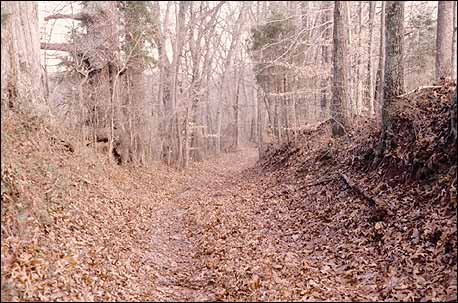|

The
Human Meaning of Removal
 |
This photo shows a segment of road believed to have been
used during the Cherokee removal of 1838.
Tennessee
Department of Environment and Conservation, Benjamin Nance,
photographer |
Read
the following documents and describe the hardships and dislocations
that the Indians faced along the Trail of Tears.
- Eliza
Whitmire was about five years old when she and her
parents, who were enslaved to a Cherokee family, were forced
to leave Georgia. She later described the process of removal.
Read Whitmire's account
- Elizabeth
Watts,
a Cherokee woman whose mother was born along the Trail of Tears,
described the trek westward.
Read Watt's account.
- General
Winfield Scott orders the Cherokee people not to resist
the removal order.
Read Scott's orders.
- Lt.
L.B. Webster, who accompanied the Cherokee along part
of the Trail of Tears, offered a first-hand account of the journey.
Read Webster's account.
- Private
John G. Burnett, who also accompanied the Cherokee
westward, described what he saw.
Read Burnett's description.
- Jane
Bushyhead, a Cherokee girl, wrote a letter to a friend
about the impending forced removal of the Cherokees.
Read Bushyhead's
letter.

Routes of the Trail of Tears from the National
Park Service
Trail of Tears National Historic Trail: http://www.nps.gov/archive/trte/index.htm
The Trail of Tears National Historic Trail commemorates
the removal of the Cherokee and the paths that 17 Cherokee detachments
followed westward. Today the trail encompasses about 2,200 miles
of land and water routes, and traverses portions of nine states.
|
